Snowmobile boots are a vital piece of equipment for most people that participate in the sport, protecting, warming, and supporting feet during long days out on the sled. While those who are new to the sport or are just getting together all of their equipment sometimes use a sturdy pair of winter boots, after a snow machine and a helmet, a snowmobile-specific boot shouldn’t be far behind on your shopping list.
Snowmobile boots are typically windproof, meant to withstand extreme temperatures (around -60 degrees Fahrenheit). Many models are also DOT approved, which means they’re not only certified to protect your feet and ankles in the event of a crash, but they’re also crash tested and designed around rigorous safety standards. Lastly, they’re rigid, meaning they can support your weight as you shift around on the sled, making performing complex maneuvers easier and allowing you to move more quickly and more effectively around tight trail networks.
- Features to Consider in a Snowmobile Boot
- Top 10 Best Snowmobile Boots 2025
- 1. Best Overall Pick: Castle X Charge BOA Snowmobile Boots
- 2. Best Premium Pick: Klim Klutch GTX BOA Boot
- 3. Best Budget Pick: Joe Rocket Men's Snowmobile Boot
- 4. Best Women’s Snowmobile Boots: Kamik Women’s Canuck Boot
- 5. Best High-Tech Boot: FXR X-Cross Pro Speed Boots
- 6. Best Cold Weather Boot: Baffin Impact Boot
- 7. Best Leather Snowmobile Boot: Castle X Force 2
- 8. Most Versatile Men’s Snowmobile Boot: Sorel Men’s Bear XT
- 9. Most Versatile Unisex Snowmobile Boot: Klim Adrenaline GTX
- 10. Most Breathable: Fly Racing Marker BOA Boots
- Guide to Buying the Best Snowmobile Boots for 2025
- FAQ
- Wrapping Up
Features to Consider in a Snowmobile Boot
There’s plenty to think about when shopping around for a snowmobile boot, from fashion (does it match with your sled?) to warmth (does it match with the forecast). We’ve identified the following as the most fundamental parts to watch out for when looking for a snowmobile boot.
Protection
An average sled can get up to 95 miles per hour while a higher speed snowmobile hits over 150 mph. When riding quickly, a snowmobile boot is nearly as important as a helmet or any other personal protective equipment, protecting your legs, shins, and feet from debris and supporting them in the event of a crash.
Weatherproofing
Also, make sure your snowmobile boot is both waterproof and breathable, as moisture is the enemy of warm feet. Keeping your feet toasty and safe from frostbite is more about the design of your boot than the sheer quantity of insulation.
Insulation
There are about as many insulation types as models of boots, with everyone taking a different approach to the most fundamental part of a winter boot. From natural compounds like wool to fancy synthetics that sometimes work great and sometimes don’t, make sure you’re paying attention to how your boot is insulated.
Enclosure Mechanism
Keeping your boot sealed with a reliable fastener is the best way to make sure you’re keeping the weather out. The following fasteners are the most common in the snowmobile market.
- Laces: A classic, simple, and inexpensive enclosure mechanism, laces provide consistent pressure although wear out over time and can become untied.
- Boa: The Boa enclosure system applies even pressure around the ankle and can’t become untied, although they’re much more expensive than other enclosures
- Ratchet: Tightening with a series of clicks, ratchets are constructed with plastic and metal. While these don’t loosen up over time and are easy to use on the go, sometimes snow can get in the way and gum up the works.
- Velcro: Velcro is a classic- quick, reliable, and inexpensive. It’s sometimes referred to as a ‘hook-and-loop’ enclosure, unfortunately, it loses the ability to cinch down tightly over time.
- Elastic: While an elastic cord or cinch is usually not the only enclosure method, the material is often used over the top cuff of a boot to keep out snow and provide a seal that keeps the weather out, like a small gaiter.
Versatility
The last thing to consider with a snowmobile boot is its versatility: what exactly are you using it for? While serious snowmobilers might look for something with a high degree of protection that’s less comfortable while walking, those who are using their snowmobile as a tool to get around in the winter will want something warmer and more comfortable to walk in. Make sure your boot matches its intended application.
| Product | Enclosure Mechanism | Insulation | Weatherproofing | Rating |
|---|---|---|---|---|
| Castle X Charge BOA Snowmobile Boots | Boa | 3-layer Merino Wool | Cordura Nylon | 5 |
| Klim Klutch GTX BOA Boot | Boa | Thinsulate Water-Resistant 800G | Gore Tex/Michelin Rubber Outsole | 4.5 |
| Joe Rocket Men's Snowmobile Boot | Velcro, Ratchet enclosure | DuPont and Thermolite Insulated Liner | Waterproof Scotch Guard Genuine Leather | 4.5 |
| Kamik Women’s Canuck Boot | Laces with Elastic Cuff | 8mm Zylex Liner | 1000 Denier Nylon/Rubber | 4.5 |
| FXR X-Cross Pro Speed Boots | Laces | Synthetic | 2mm Rubber Coating | 4.5 |
| Baffin Impact Boot | Buckle and Elastic | Baffin Multi-Layer Inner Boot System | Rubber Base | 4.5 |
| Castle X Force 2 | Laces | Natural Wool Blend | DRY-X membrane | 4 |
| Sorel Men’s Bear XT | Laces with Elastic Cuff | Heat-Reflective Lining | PU-Coated Synthetic Textile | 4 |
| Klim Adrenaline GTX | Laces | 3M Thinsulate | Gore-Tex | 4 |
| Fly Racing Marker BOA Boots | Boa | Thinsulate 600G | Hydroguard | 3.5 |
Top 10 Best Snowmobile Boots 2025
1. Best Overall Pick: Castle X Charge BOA Snowmobile Boots

Editor’s Rating:
At a Glance
- Enclosure Mechanism: Boa
- Insulation: 3-layer Merino Wool
- Weatherproofing: Cordura Nylon
Review
Like most other Castle boots, these 3-layer Merino wool boots are rated to -60 degrees Fahrenheit, although while less expensive boots get the job done with synthetic, these ones accomplish the task with more premium materials than other Castle boots like the Castle X Force 2 Men’s Snowmobile Boot.
The Merino wool, in fact, is layered in between a moisture-wicking air mesh and perforated air foam, yielding a construction that’s warm but won’t ever mean you end up with wet feet. Like other Castle boots, these protect the feet from external water using polyurethane coated outer materials and 100D nylon (originally known by its brand name, Cordura nylon), which is permeable from inside, allowing sweat to evaporate, but not letting water in from the outside.
Our favorite part, though, and what makes these boots cost about $50 more than other Castle models, is the Boa attachment system, located at the top cuff of the boot and cinching down on the ankle without applying too much pressure.
While laces can become untied and cut off circulation when not tightened down evenly, the Boa system is warrantied, designed to tighten across the entire surface of the leg and ankle, and continues to be effective and easy to operate even in the cold and snow.
Pros
- Three layers of Merino wool keep the feet warm
- Cordura nylon is impermeable yet breathable
- Boa attachment system is effective and easy to use
- These boots use more premium materials than other models
Cons
- About $50 more than comparable models
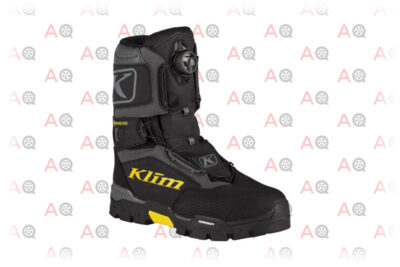
Editor’s Rating:
At a Glance
- Enclosure Mechanism: Boa
- Insulation: Thinsulate Water-Resistant 800G
- Weatherproofing: Gore Tex/Michelin Rubber Outsole
Review
Top to bottom, this boot is just about as good as it gets: a Boa system provides even retention around the ankle and calf and 800 gram Thinsulate material offers insulation resistance to even the coldest days. In fact, the manufacturer, Klim, even took the step of paying for the rights to use one of the industry’s most expensive materials: Gore Tex.
So there’s no question the boot is going to be great, especially considering the fact that it manages to stack on further name brand features like a Michelin rubber outsole and a Ortholite insole. So the question becomes, then, is the boot worth the high price of these expensive features?
It’s a complicated question, and in an already expensive sport, it feels easy to say yes. A boot is a small, small fraction of the price of a snow machine, so any accessory is going to feel significantly more economical than an additional purchase.
Still though, there are plenty of boots at half the price of this one. Our verdict: if you’re looking for high-performance equipment, buy this boot. If you’re looking for a more niche boot or something more versatile, you’re better off with something more economical.
Pros
- Incorporates proprietary designer materials into its construction
- Boa system gently locks the boot into place
- Relatively inexpensive compared to other snowmobile equipment
- Thinsulate material
Cons
- Not worth the high price unless you need high performance
- Niche users might be better off buying something more economical
3. Best Budget Pick: Joe Rocket Men's Snowmobile Boot
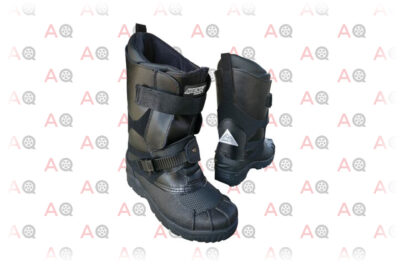
Editor’s Rating:
At a Glance
- Enclosure Mechanism: Velcro, Ratchet enclosure
- Insulation: DuPont and Thermolite Insulated Liner
- Weatherproofing: Waterproof Scotch Guard Genuine Leather
Review
These inexpensive boots aren’t the most technologically advanced, but they do incorporate several different types of proprietary or patented materials to maximize the efficacy of the boot. The outer construction is made of a material called Scotch Guard leather, a type of leather that’s supple and waterproof, allowing the exterior to be completely weatherproof.
Unfortunately, though, this means that you’ll have to frequently wipe down the external part of the boot, as weather when not cared for properly begins to decay. The inside contains a DuPont and Thermolite insulated booty to keep the foot itself warm, claiming to be effective up to an incredibly frigid -60˚F, a temperature that we hope you’ll never have to endure.
While a ratchet enclosure cinches down the bottom of the boot, the cuff of the boot relies on Velcro, which is not quite effective at keeping snow and wind from entering the top of the boot. This reduces the efficacy of the entire boot itself.
We wish that the top cuff incorporated a Boa enclosure or at least a ratchet enclosure to keep that top cuff tight around the calf, providing an insulative seal around the leg. They’re great for budget buyers, but if you’re looking for the top of the line, check out the Klim Klutch GTX Boa Boot.
Pros
- Uses Scotch Guard leather for waterproofing
- Dupont/Thermolite insulation in booty
- Effective up to -60˚F
- Ratchet enclosure tightly cinches down the bottom of the boot
Cons
- Velcro cuff isn’t great at insulating the top of the boot
- Leather requires some care
4. Best Women’s Snowmobile Boots: Kamik Women’s Canuck Boot
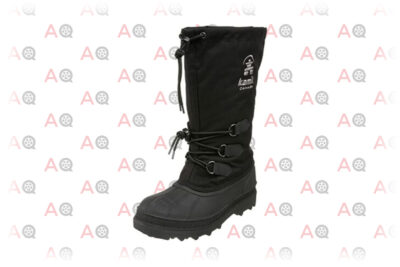
Editor’s Rating:
At a Glance
- Enclosure Mechanism: Laces with Elastic Cuff
- Insulation: 8mm Zylex Liner
- Weatherproofing: 1000 Denier Nylon/Rubber
Review
Although this boot technically isn’t a snowmobile boot, it contains many of the technical, proprietary materials that have come to be expected in recent years on snowmobile specific models. This starts with a 1000 Denier nylon upper, a material that’s both insulated and waterproof, keeping your feet dry even in slushy conditions. Internally located is an 8mm Zylex liner, removable in case it needs to be dried or cleaned, adding another layer of warmth.
So what makes this good for snowmobiling, then? Firstly, it’s got an impressive cuff length, completely necessary if you’re looking for a non-snowmobile-specific boot that will work with your sled. This high cuff length won’t just protect you from a crash, it’ll better protect you from the snow that gets kicked up when riding.
If you’re looking for a versatile, high-cuffed mens’ boot, check out the Sorel Men’s Bear XT Insulated Winter Boots.
The last important part is the construction of the sole and of the upper. A thick rubber sole and upper wraps all the way around the top of the foot, stopping just sort of the ankle, protecting against more injuries than boots where only the sole itself is rubber. An elastic ring tops off the gaiter, and a relatively outdated lace-up retention is effective at evenly cinching down the cuff, but can become untied at inconvenient moments.
Pros
- High-cuffed boots will protect from crashes and the elements
- Thick rubber sole and upper helps with waterproofing
- Elastic ring seals the gaiter
Cons
- Laces can become untied at inconvenient moments
- Not technically meant for snowmobiles
5. Best High-Tech Boot: FXR X-Cross Pro Speed Boots

Editor’s Rating:
At a Glance
- Enclosure Mechanism: Laces
- Insulation: Synthetic
- Weatherproofing: 2mm Rubber Coating
Review
As a snowmobile-specific boot, these technical looking and feeling options from powersports company FXR have a feature that non-snowmobile-specific boots simply won’t have: a DOT and FMVSS (Federal Motor Vehicle Safety Standard) certification, meaning your feet and ankles will be well protected in the case of an accident.
Fastening with laces, it doesn’t use the most technologically advanced fasteners, but the tech has been around for hundreds of years and isn’t going anywhere. In fact, this design of lace is actually complemented by the boots two-piece tongue construction, which allows it to provide a strong seal around the calf, keeping wind and snow out. They’re rated to an impressive -40˚F, which isn’t the best in class but for a pair of rigid snowmobile-specific boots is pretty darn impressive.
Lastly, the boots are supportive. A fixed liner keeps the foot in place, a 20mm thick EVA footbed provides support, and 2mm of rubber keeps water out when slogging around in the wet. With unisex colorways that accomodate feet from women’s size 5 all the way up to men’s 13, these will accommodate just about any size foot.
Pros
- Supportive and insulative two-tongue construction
- 2mm of rubber for waterproofing
- DOT and FMVSS certification
- Unisex colorways with a wide range of sizes
Cons
- Insulation rating isn’t great for the category
- Laces as a fastening mechanism aren’t particularly impressive
6. Best Cold Weather Boot: Baffin Impact Boot
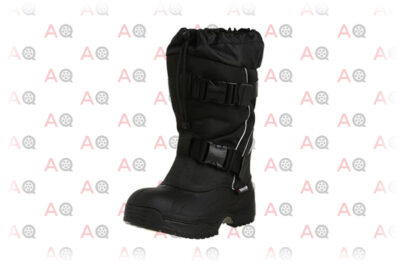
Editor’s Rating:
At a Glance
- Enclosure Mechanism: Buckle and Elastic
- Insulation: Baffin Multi-Layer Inner Boot System
- Weatherproofing: Rubber Base
Review
While Baffin isn’t necessarily a huge name in snowmobiles, it is a well-known brand in general winterwear, providing phenomenal, winterproof, waterproof products at a relatively economic price. Unfortunately, though, they’re not snowmobile specific, meaning that among other small details, the boots are not DOT approved, although the sheer nylon boot outer layer should provide at least some protection in the event of a crash.
The boot is rated to a ridiculous -148ºF, which we hope you never have the misfortune to encounter (it’s actually colder than the coldest temperature ever measured on earth). So just because a hypothetical foot could survive that low of a temperature in this boot doesn’t mean that an ultra-warm boot doesn’t provide benefits: even at a relatively balmy 0ºF, your foot will be more comfortable than if you were using a warmer-weather boot like the FXR X-Cross Pro Speed.
The inner layer, which incorporates a removable booty, uses Baffin’s multi-layer system to insulate the foot, although that messes with conventional sizing. Over time, that liner will stretch out, but not to the extent that you should purchase your standard size. As with most snowmobile boots, purchase approximately one size up. If you happen to get the wrong size, you could experience hot spots and friction.
Pros
- Boots will keep you warm even in ridiculously low temperatures
- Incorporates a three-layer removable booty
- Sheer nylon provides protection in the event of a crash
- Liner stretches out over time, accommodating foot size
Cons
- Purchasing the wrong size yields hot spots and friction
- Liner stretches out over time
- Not DOT approved
7. Best Leather Snowmobile Boot: Castle X Force 2
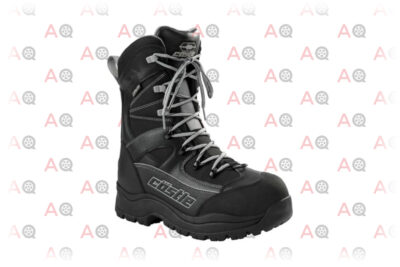
Editor’s Rating:
At a Glance
- Enclosure Mechanism: Laces
- Insulation: Natural Wool Blend
- Weatherproofing: DRY-X membrane
Review
With a lace enclosure, these boots are bit older school in terms of construction but as modern as the best of them with regards to function. Although at first glance, the design and detail features look similar to older boots, the retro (or at least traditional) look hides the advanced materials and tech that makes these boots a lot more advanced than they appear.
Made of a breathable, wicking, natural wool blend, the removable insole has a waterproof and metallic heat layer insulating the boot. Primarily, though, the waterproofing can be credited to Castle’s proprietary DRY-X membrane, and the polyurethane coating around the entire outer layer of the boot. It’s about as warm as boots rated to 40˚F, like the FXR X-Cross Pro Speed boots.
As they’ve got a bit of leather, they’ll require a bit more care than with fully synthetic boots, and you’ll have to wipe down and dry off the boot every time it gets wet or salty. We do like the design touch, and the dark color scheme, though, and the leather contributes to an overall more durable makeup. Not interested in the leather boot outer layer construction? The same boot also comes in high-vis and women’s versions.
Pros
- Rigid snowmobile boots have a retro look and advanced construction
- Includes Castle’s proprietary DRY-X membrane
- Come in high-vis and women’s versions
Cons
- Leather requires some care after use
- Has a slightly retro look
8. Most Versatile Men’s Snowmobile Boot: Sorel Men’s Bear XT
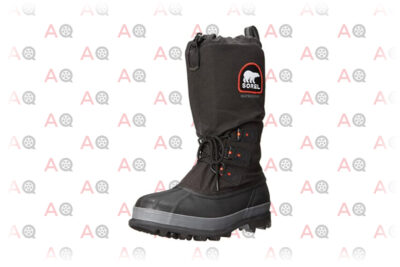
Editor’s Rating:
At a Glance
- Enclosure Mechanism: Laces with Elastic Cuff
- Insulation: Heat-Reflective Lining
- Weatherproofing: PU-Coated Synthetic Textile
Review
First of all, we have to say that this boot is not snowmobile-specific, meaning it’s not DOT approved like FXR X-Cross Pro Speed Boots and therefore not as safe in potential accidents as other boots. Simultaneously, though, if you’re using a sled as a tool to get around in the winter more than as a recreational vehicle, you’ll need a pair of boots like this that will be equally effective for work.
While these are sturdy and stiff enough for snowmobile use, where these boots really shine is out while working. Take, for example, their 13-inch cuff, which, covered by an elastic flexible gaiter does an impressive job of keeping snow out even when tromping around snowdrifts that get even above the top of your boot. Count on impressive water protection as well, as the PU (Polyurethane) coated plastic doesn’t just seal out water, it lets the foot breathe as well.
These boots, however, have some weak points as well. The sole is highly profiled, meaning that while they’re good for hiking, these boots don’t stick to the footboards as well as flat-bottomed boots that are specifically meant for the task. It shouldn’t be a problem for a casual user, but it’s a bit more of a challenge for snowmobilers riding aggressively.
Pros
- Impressive water protection and weather resistance thanks to long cuff
- Highly profiled sole is good for hiking
- Phenomenal for winter work
- Allows foot to breathe
Cons
- Grip is a problem for snowmobilers who ride aggressively
- Boot is not as safe in accidents as snowmobile-specific options
9. Most Versatile Unisex Snowmobile Boot: Klim Adrenaline GTX

Editor’s Rating:
At a Glance
- Enclosure Mechanism: Laces
- Insulation: 3M Thinsulate
- Weatherproofing: Gore-Tex
Review
A solidly-constructed boot meant to be versatile for use both on and off the sled, these boots from Klim, a largely snowmobile-specific company, are a great option for those who want a snowmobile specific boot that can be used for other purposes as well. Rigid enough for maneuvering a sled and shifting weight while on powdery snowmobile trails, they also come with features that make them fine for slogging around the snow without a snow machine.
Loaded up with multi-layered construction for heat retention and a thin sheet of 3M Thinsulate insulation, adding both waterproofing and a chance for more heat capture. The exterior is durable as well, especially when weighing it against other synthetic alternatives, primarily woven nylon and synthetic rubber.
Unfortunately, they’re not the most breathable, and they’re not technically snowmobile-specific or DOT approved, meaning they won’t be as safe in the event of a crash, nor are they great for the most aggressive of riders. Fortunately, Gore Tex means that they’ll still slide instead of catch in a crash, and solid ankle support means they’re much more sturdy than other snow boots.
Pros
- Snowmobile specific boot that can be used for other purposes
- Rigid enough for maneuvering on snow but flexible enough for hiking
- Multi-layered construction
- Made of woven nylon and synthetic rubber
Cons
- Not DOT approved
- Not snowmobile-specific
10. Most Breathable: Fly Racing Marker BOA Boots
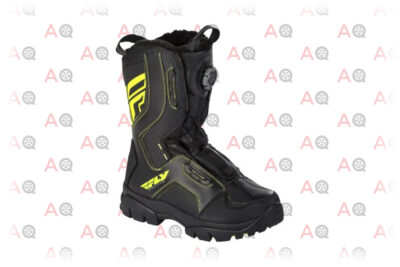
Editor’s Rating:
At a Glance
- Enclosure Mechanism: Boa
- Insulation: Thinsulate 600G
- Weatherproofing: Hydroguard
Review
Fly Racing is traditionally a motocross-centered company, but has expanded into other sports recently, offering products in everything from water sports to mountain biking. Thankfully for snowmobilers, they’ve also begun to produce sturdy products for snowmobilers, although they’re slightly more expensive than comparable products from more established manufacturers.
Taking knowledge from years of producing all-condition, no-holds-barred motocross boots, Fly Racing incorporates their universal Hydroguard system with this pair of boots, preventing water penetration while simultaneously allowing the feet to breathe. Still not quite at the level of major manufacturers, unfortunately, these boots are only rated down to -40˚F, not the standard -60˚F we’ve come to expect from other manufacturers.
Our favorite part of these boots, by far, is their thick and grippy rubber sole. It’s full of almost cleat-like rubber protrusions, perfect for clawing your way up packed, icy surfaces, with the rubber soft enough to help maintain a grip on the foot platforms of your snow machine. This yields a snowmobile boot that’s rigid enough for maneuvering the sled while being grippy enough for a bit of backcountry hiking.
Pros
- Grippy sole is great for hard-packed icy surfaces
- Hydroguard system is breathable but doesn’t let water in
- Sturdy products are good for snowmobilers
Cons
- Not rated to the -60˚F we expect from other manufacturers
- Company is new to production of snowmobile products
- Products are slightly more expensive than comparable models
Guide to Buying the Best Snowmobile Boots for 2025
Snowmobiling is an incredible sport, one of the best and most exciting ways to enjoy a winter landscape. While it’s more accessible than other motorsports from a price and skill perspective, riders still need to invest in the best equipment. An important part of this? A solid, rigid, and protective pair of snowmobile boots.
Pro Boot Tips for Snowmobilers
Many new sled riders are still learning quickly about the sport, and that’s fine: snowmobilers are a warm and welcoming community. Here are some of the tips for maximizing your boots from snowmobiling old-timers.
- Size Up: A smart move for anyone with a sled is to size up on your winter boots from your normal street shoe size. This will give you room for thicker wool socks, or, on those really cold days, even a whole extra pair of socks.
- Dry Feet: The most important thing you can do to keep your feet warm is to keep them dry. Sweaty feet? Bring a pair of socks to change into. Make sure your boots are waterproof but breathable, like these boots from Sorel.
- Plastic Bags: Get yourself in a jam where your feet are colder than you expected? Stick your socked feet in a plastic bag, then pop your boots on. It’s not breathable, but it’ll keep out the wind and work in a pinch.
- Watch Out for Salt: There’s no enemy of the snowmobiler more vile than road salt. If you do happen to get on some salty trails, roads, or road crossings, make sure you give your boots a wipe down with a wet rag to remove the compounds, which can deteriorate your boot over time.
Preference Considerations for Snowmobile Boots
We’re not going to state our own opinions on these factors that go into selecting a snowmobile boot, but these factors are good to consider based on your own unique considerations as a snowmobiler.
- Work Boots vs. Snowmobile Specific Boots: While serious ‘bilers might look for something rigid, made by a snowmobile apparel brand, and meant to get along with the rest of your snowmobiling equipment, those who are using a snowmobile as a work vehicle might be okay with a more multipurpose boot. If you just happen to get around in the winter using a snowmobile, you can get the job done with something a bit more universal, sturdy, and meant for work.
- Rigid vs. Flexible: While a rigid boot is a quintessential piece of snowmobile equipment, helping with balance and weight shifting while on the snow, a flexible boot can go a long way with keeping the foot comfortable and warm. Casual riders might prefer a less rigid boot, those really moving around on the sled frequently will want something rigid.
- Removable Booty vs. Sewn-In Liner: Typically, a removable booty that slides into your boot is slightly warmer, providing an additional layer of air and an opportunity to dry out your boot. Sewn-in liners are cheaper and often provide thicker insulation, although they can hold onto smelly odors and be hard to dry out. More expensive boots like the Klim Klutch GTX Boa Boot have removable liners.
Snowmobiling Personal Protective Equipment
As with all powersports, snowmobiling presents a distinct danger that needs to be recognized and taken seriously. Make sure you incorporate the following into your attire when prepping for a day out:
- Helmet: While many people choose to use a universal motorsport helmet when snowmobiling, having proper insulation makes the difference on colder days. Make sure it’s certified compliant to DOT standards, minimum, and think about purchasing something with MIPS to avoid concussions in case of a crash.
- Boots: Although the most important thing is that your boots get above your ankle, a larger, rigid boot that protects your ankle and shin should be purchased to protect your legs and feet. Foot/leg injuries are the second most common type of injuries in power sports.
- Face Shield or Goggles: Debris, snow, and wind can all affect visibility and thus your safety. Goggles are the most popular type of snowmobile eye protection, but face shields are seen relatively frequently as well.
- Clothing: Snowmobile-specific clothing doesn’t only keep you warm, it provides padding and allows you to slide in case of a fall.
- Avalanche Beacon: If you’re on your snow machine in mountainous terrain and deep snow, there’s always the risk of avalanche. Consider an avalanche beacon to aid in a potential rescue situation. While it won’t directly protect you from an accident, it might save your life after one.
FAQ
Snowmobilers are a curious bunch: here are a few answers to some of your most pressing questions on snowmobile boots.
How Is Insulation Measured?
600g, 1000g, -60˚F, -40˚F: we’ve all seen companies classify boots in different ways, but what do these numbers really mean, and how accurate are they for comparison purposes?
Numbers that end in G refer to the insulation inside the boot itself, measured in grams. This number stands for grams per square meter of insulation, meaning higher numbers are more dense and thus more insulative. This number is objective, meaning it can’t be fudged, faked, or exaggerated.
Temperature is a different story, and different manufacturers have different ways of measuring their boots’ minimum temperature. Due to the subjectivity of the practice, manufacturers have begun to do away with these ratings, but it originally was a measure based on the amount of insulation required to stay out at the designated temperature for a single hour. Use this metric to compare boot models within brands, but not necessarily between them.
Are Muck Boots Good for Snowmobiling?
Most people who live in snow-prone lands know the value of a good pair of muck boots. The fact that they’re completely water-impermeable and can be packed with a few layers of wool socks makes them a tempting choice for many snowmobilers, especially those who don’t want to shuck out a few hundred bucks for something snowmobile-specific.
Unfortunately, using a pair of muck boots on your snowmobile is not a great idea. They’re simply not rigid enough, meaning the bumps and jumps will be absorbed by the ankle instead of the boot itself, leading to potential injury. They’re also not warm enough, and their impermeable rubber will mean your feet will sweat and get wet instead of evaporating away moisture.
Are Snowmobile Boots Worth It?
As with most other products, the question as to if snowmobile boots are ‘worth it’ is a complex one that depends on a lot of different factors. Our recommendation for a good guideline? If you’ve got your own snowmobile, it’s worth it to pick up a pair of boots. If you’re renting or borrowing a snow machine more than riding your own sled, you’re probably fine with some standard, sturdy, winter boots.
Is a BOA Attachment System Worth It?
From the Tour de France to the PGA, and recently a host of snowmobiling boots, the BOA attachment system has swept the sporting world due to the fact that it provides a consistent, gentle pressure, holding the shoe tightly in place without the hotspots or friction of other shoe attachment methods. It also doesn’t loosen or untie. It’s not essential, perfect, or inexpensive, but if you have the funds, it’s probably the best attachment method out there.
What Are the Advantages of Snowmobile Boots?
Snowmobile boots don’t connect to anything, aren’t special, they’re not even warmer than other types of winter boots. So what’s so necessary about them, then? First of all, snowmobile boots provide more protection than traditional boots, helpful in the event of a wipeout. Secondly, they’re more rigid, helping with control of the sled and reducing fatigue. Lastly, they’re designed for snowmobilers. While leather boots were fine in the early days of snow machines, they’re dated and out of style for the sleds and trends of today.
Other Products for Snowmobilers
Snowmobiling is an expensive hobby, and it’s not necessary the sled itself that ends up being the priciest part. There are plenty of products that make a snowmobiler’s life a lot easier, be it fun gadgets or workhorse loading ramps.
- Loading Ramps: It’s a snowmobiler’s dream to be able to roll straight out of the garage onto a trail network, but for most of us it’s simply not feasible. A quality loading ramp helps get your sled up onto your trailer without too much difficulty.
- Gloves: It’s important to take care of your most vital steering equipment, your hands and fingers. Don’t skimp on them and they won’t wimp out on you.
- Helmet Speakers: Whether you’re looking for a way to listen to music while snowmobiling, you’re trying to chat with your riding buddies, or you just want to be able to follow along with voice navigation from your GPS, a helmet speaker fits right into your helmet.
Wrapping Up
Snowmobile boots are a vital piece of snow machining equipment, not only keeping you safe by providing a layer of insulation between you and the harsh elements, but also by providing a rigid and sturdy layer of protection between you and the ground. They’re not only vital for keeping out the cold, but also for making sure that you’ll be safe and sound in the event of an accident. At the end of the day, they’re the perfect complement to a snowmobiler and the perfect gift for anyone who loves getting out on their sled.


